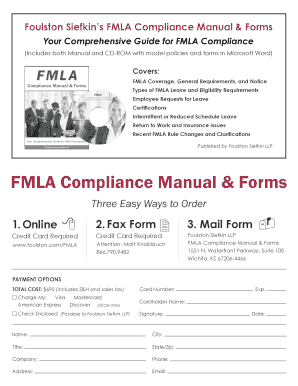FMLA Paperwork Example: How to Fill it Out Easily

Applying for leave under the Family and Medical Leave Act (FMLA) can seem like a daunting task, especially when you're already dealing with personal or family health issues. However, with the right information and a structured approach, you can navigate this process smoothly. Here's how to fill out FMLA paperwork effectively and what you need to know about the process.
Understanding FMLA Eligibility

Before diving into the paperwork, ensure you qualify for FMLA:
- You must work for a company with at least 50 employees within a 75-mile radius.
- You should have worked for the employer for at least 12 months.
- You must have worked at least 1,250 hours during the 12 months prior to the start of your leave.
Types of FMLA Leave

FMLA allows for several types of leave:
- Childbirth or care of a newborn.
- Adoption or foster care placement.
- Personal or family medical conditions.
- Caring for a family member with a serious health condition.
- Military family leave, including care for a service member or qualifying exigency.
The FMLA Process

Here’s a step-by-step guide to completing your FMLA paperwork:
1. Obtain the Forms

The first step is getting the FMLA forms from your HR department or directly from the U.S. Department of Labor’s website:
- WH-380-E – Certification of Health Care Provider for Employee’s Serious Health Condition
- WH-380-F – Certification of Health Care Provider for Family Member’s Serious Health Condition
- WH-381 – Designation Notice
- WH-384 – Employee’s Notice of Intent to Return to Work
2. Complete Your Portion

Fill out your section of the form carefully:
- Enter your personal information accurately.
- Specify the type of leave you’re requesting.
- Describe the anticipated duration of your leave if known.
3. Medical Certification

Get your medical certification form filled out by your healthcare provider or your family member’s provider. Key points include:
- Medical history
- Details of the condition
- Expected treatments or appointments
- Estimated duration of leave
⚠️ Note: Be aware that your healthcare provider might not always have enough information to complete the form fully, and you might need to follow up.
4. Submit Your Forms

After filling out your portion and obtaining the medical certification:
- Submit the completed forms to your HR department or FMLA coordinator.
- Ensure you keep copies for your records.
5. Employer Review and Approval

Your employer will review your application:
- If approved, you’ll receive a Designation Notice (WH-381).
- If denied, you’ll get written reasons for the denial.
6. Tracking Your Leave

Keep track of:
- Hours or days of leave taken.
- Ensure your leave does not exceed the 12-week limit (or 26 weeks for military caregiver leave).
7. Returning to Work

Plan your return to work:
- Notify your employer if you need to extend your leave or if you’re ready to return.
- Complete the WH-384 form to formalize your return.
Tips for a Smooth FMLA Experience

- Communicate clearly and proactively with your employer.
- Know your rights, including job protection and health insurance continuation.
- Plan ahead; start the FMLA process as early as possible.
Once you've navigated through the paperwork and potentially taken your leave, summarizing the key points ensures you're well-informed about the process:
The FMLA application process involves understanding eligibility, gathering forms, completing them accurately with medical certification, submitting them to your employer, and preparing for your return to work. Keeping records and communicating effectively with your HR team can make this process smoother. Remember, FMLA is there to support you during important life events, so take advantage of this employee benefit when needed.
What if my employer denies my FMLA request?

+
If your FMLA request is denied, your employer must provide written reasons for the denial. If you believe this decision is incorrect or based on incomplete information, you can appeal or contact the Department of Labor for guidance.
Can I take FMLA leave intermittently?

+
Yes, you can take FMLA leave on an intermittent or reduced schedule basis if medically necessary for your condition or your family member’s condition. This should be documented by your healthcare provider.
How do I handle my work responsibilities during FMLA leave?

+
Discuss with your employer ahead of time about how your work will be managed during your absence. This might include delegating responsibilities, arranging for coverage, or handling urgent matters before your leave starts.